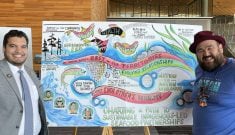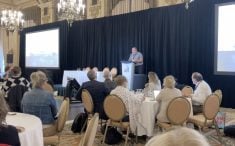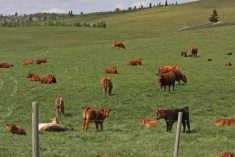Four representatives of the South East Cornerstone School Division in Weyburn, Sask., walked into the lion’s den in Saskatoon March 14 when they appeared on a panel at the Saskatchewan Association of Rural Municipalities convention.
School closures and education taxes are hot button issues for rural residents these days, but only one exchange with SARM delegates was nasty, and there was no talk of withholding property taxes as was heard at recent SARM conventions.
During a question period after the school board’s presentation, Stewart Thiessen of the RM of Eyebrow accused the panel of rambling and offering no new information.
Read Also

Know what costs are involved in keeping crops in the bin
When you’re looking at full bins and rising calf prices, the human reflex is to hold on and hope for more. That’s not a plan. It’s a bet. Storage has a price tag.
Thiessen drew applause from the 1,700 at the SARM meeting when he suggested that instead of closing rural schools, school boards could bus urban students to country schools to keep rural jobs and towns alive.
In response, Cornerstone board chair Audrey Trombley said school boards did not create the system, and all trustees are concerned about how much time students spend on buses.
“I wouldn’t travel an hour and 20 minutes to go to work in Regina. I don’t want kids travelling 1½ hours on the school bus.”
Trombley also said administration takes 1.3 percent of the Cornerstone budget. The biggest expense, at 50 percent, is teachers’ salaries.
A delegate from the RM of Wood River urged trustees to use innovative solutions such as a two day school week and computer technology to reduce the amount of time students spend on the road.
Trombley agreed that high speed internet would allow a teacher in one location to deliver a lesson to students elsewhere. Such distance education would keep small schools open while ensuring the quality of education does not erode, she added.
No one runs as a trustee to be popular, Trombley said. Twelve of the 41 schools in her division are at risk of closure, and the board has eliminated five offices and laid off five administrators under last year’s restructuring.
She said creating community councils for each school will help ensure local accountability. In addition to the five to nine community representatives, each council includes a teacher, a principal and a high school student when applicable to bring a classroom perspective. She said 456 people sit on Cornerstone’s 41 councils.
The division’s superintendent of finance, Lionel Diederichs, told SARM that the Saskatchewan school system has more local autonomy than in most provinces.
However, Diederichs said the province also has Canada’s highest dependence on property tax to fund kindergarten to Grade 12 education. He said provincial figures show that property taxes contribute 47.5 percent of the education budget. In the United States, local property tax supplies 33.7 percent of education funding.














